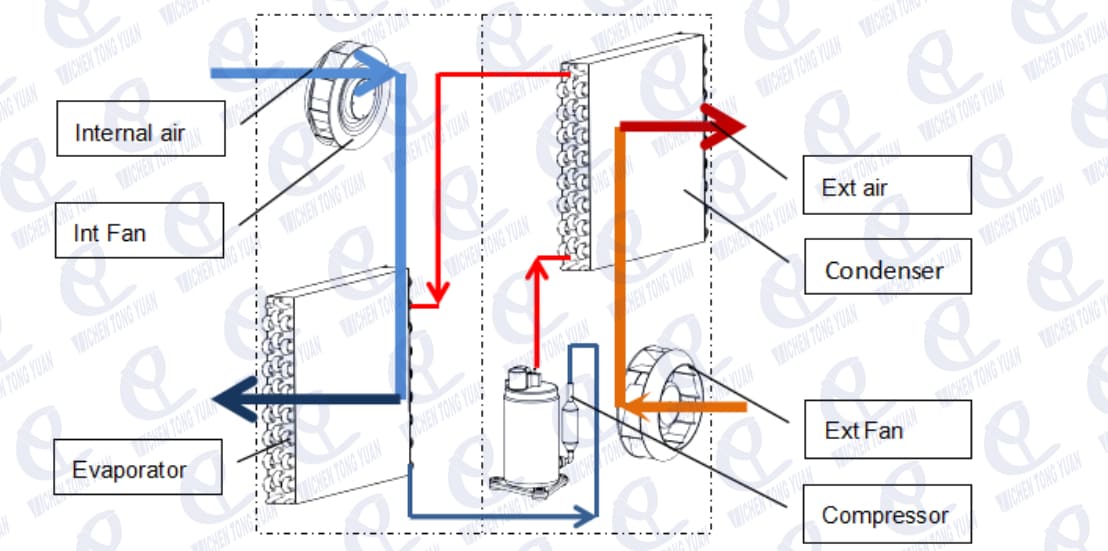How to Choose Thermal Management Solution for Energy Storage System
Choosing the right Thermal Management Solution for Energy Storage System involves considering several factors to ensure it meets your specific needs and maximizes efficiency and cost savings. Here’s a comprehensive guide to help you make an informed decision:
Assess Your Cooling Needs
◆ Size of the Area:
Determine the size of the area you need to cool. Air conditioners are rated by their cooling capacity, measured in BTUs (British Thermal Units). Ensure the Thermal Management Solution for Energy Storage System is appropriately sized for your space.
◆ Cooling Load:
Consider the cooling load, which includes factors like insulation, number of windows, occupancy, and heat-generating appliances. This will help you determine the capacity required for efficient cooling.
Evaluate Energy Storage Capacity
◆ Battery Type:
· Lithium-ion: Offers higher energy density and longer cycle life but is more expensive.
· Lead-acid: More affordable but has a shorter lifespan and lower energy density.
· Other Technologies: Explore advanced options like flow batteries or solid-state batteries if they meet your needs.
◆ Storage Capacity:
Assess your energy usage patterns to determine the required storage capacity. Consider the duration of potential power outages and your peak energy consumption periods.
Consider Efficiency and Performance
◆ Energy Efficiency Ratio (EER) and Seasonal Energy Efficiency Ratio (SEER)
Higher EER and SEER ratings indicate more efficient air conditioning systems. Look for units with high ratings to reduce energy consumption and costs.
◆ Inverter Technology
Inverter air conditioners adjust the compressor speed to maintain the desired temperature, resulting in significant energy savings compared to traditional fixed-speed units.
Check for Smart Features
◆ Smart Controls
Look for units with smart thermostats and remote control capabilities. These features allow you to monitor and control the system via smartphone apps, optimizing energy usage.
◆ Integration with Home Automation:
Ensure the EESAC can integrate with existing home automation systems for seamless operation and improved energy management.
Evaluate the Transmission Terminals
◆ Power Electronics:
Ensure the Thermal Management Solution for Energy Storage System has high-quality inverters, converters, and transformers to manage electricity flow efficiently.
◆ Communication Modules:
Look for advanced communication modules that facilitate real-time data exchange and synchronization between the energy storage system, air conditioner, and the grid.
Assess Installation and Maintenance
◆ Professional Installation:
Choose a unit that can be professionally installed by certified technicians to ensure optimal performance and safety.
◆ Maintenance Requirements:
Consider the ease of maintenance and availability of replacement parts. Regular maintenance is crucial for the longevity and efficiency of the system.
Consider Cost and Incentives
◆ Upfront and Operating Costs:
Compare the upfront costs of different units, keeping in mind that higher efficiency models may have higher initial costs but lower operating expenses.
◆ Incentives and Rebates:
Research available incentives and rebates for energy-efficient systems in your region. These can significantly offset the initial investment.
Check the Manufacturer's Reputation
◆ Brand Reliability:
Choose reputable manufacturers known for producing high-quality, reliable air conditioning systems with embedded energy storage.
◆ Warranty and Support:
Ensure the unit comes with a comprehensive warranty and reliable customer support.
Environmental Impact
◆ Refrigerant Type:
Opt for units using eco-friendly refrigerants with low Global Warming Potential (GWP).
◆ Sustainability:
Consider the overall environmental impact, including the manufacturing process and recyclability of components.
Conclusion
Choosing the right Thermal Management Solution for Energy Storage System involves balancing your cooling needs, energy storage requirements, efficiency, smart features, and budget. By carefully evaluating these factors and considering the manufacturer's reputation, installation, maintenance, and environmental impact, you can select an Energy Storage Cooling Air System that provides reliable, efficient, and sustainable cooling for your space.
Other Fault Analysis and Processing of Thermal Management Solution for Energy Storage System
Fault state | Analysis of the reasons | Solutions |
Power on the switch, the energy storage container temperature is too high but the air conditioner is not working. | | Check the power supply and the electric circuit. Setting cooling temperature according to the needs. Please contact professional maintenance. |
The air conditioner is running but the cooling effect is not good. | | To add or choose another air conditioner according to the load. Ensure the machine is used in the correct range. Please contact professional maintenance. |
The machine is stopping suddenly, and the electric system is normal. | | |







































